[:en]
Long-Term Healing after Plasma Upper Eyelid Lift High-Intensity Treatments.

There are two healing phases in localised skin tightening using electrical Plasma:
- Short-term healing
- Long-term healing
While the short-term healing results in swelling and the scabbing, the long-term healing deals with the long-term regeneration and remodelling of the skin. While the former takes place immediately after the treatment and it is over within a few days, the latter usually takes place over the course of weeks, and sometimes even months.
During the long-term healing, the skin is still subject to redness, tenderness and it is still being remodelled. The remodelling lasts as long as the tenderness is still occurring.
The long-term skin recovery period depends on several factors, in particular:
- The intensity of the treatment (remember that the treatment intensity is dependant on a number of factors, and not only the power setting of the device). In particular the longer the duration of the arc the deeper the heat will be propagated inside the skin. The closer together the spots the more intense the heat. Generally, the higher the intensity of the treatment the more intense is the redness after the procedure and the longer it takes for the long-term healing to be over.
- The duration of the long-term healing is also dependant on the individual skin recovery ability.
Certain appropriate soothing or healing products can reduce the time required for the long-term healing process.
While the short-term healing process can be easily explained by comparing it to the effects of skin burns and small injuries, the long-term healing process has to refer to something slightly different. We relate the long-term healing process to the all familiar topic of skin regeneration after mole removal or minor skin wounds recovery process soon after the scabs have fallen off. After the scabs have fallen off following plasma aesthetic treatments or minor skin injuries, the new skin is usually red and has a different texture to the rest of the skin. The area can also be itchy and tender for a while.
Also, the long-term skin recovery process is similar to that which occurs after deep skin cosmetic peels. Like in skin peels the deeper the peel penetration the longer the redness after the treatment, however generally the long-term skin recovery period after plasma treatments take longer. While a peel long-term recovery can last up to three weeks (with a feeling of tenderness and dryness of the skin) the redness and tenderness and dryness can last up to 3 months, this is normal and to be expected after plasma high-intensity treatments.
While the skin is still red and tender it is still being regenerated and remodelled. In order to understand what it is happening during the long-term healing, we will take the mole removal example. When the new skin regenerates it is of a different red/pink colour and it lacks pigmentation. Also, the texture is different.

Area a few days after plasma mole removal. The area is red soon after the scab has fallen off. The new skin will eventually return to normal colour and texture consequently blending with the surrounding skin.
Over time the skin texture and colour will return to normal and it will be difficult to tell any treatment was carried out at all.
After mole removal, the scabbing takes place. Once the scab has fallen off the area will be red and have a noticeably different skin texture than the surrounding skin. This is because the new skin has formed instead of the old skin lesion. When the new skin forms it is usually a vivid colour and it also has a noticeably different skin texture.

Detail or the right eyelid a few days after a benign skin lesion removal procedure using electrical plasma. The area is red/pink after the scab has fallen off.
The difference in colour between the treated area and the surrounding skin will slowly fade away over the following weeks. Similarly, the new skin texture will blend with the surrounding skin over the course of the following weeks.
In a similar fashion to mole removal, after localised skin tightening treatments (including plasma upper eyelid lift), the new skin will be red after the scabs have fallen off. The same applies to localised skin tightening using electrical plasma. Once the scabs have fallen off the area is of intense red colour like the one seen in mole removal. Additionally, in case of localised skin tightening, the skin will tend to regenerate due to the thermal stimulation caused by the burn inflicted by the electrical arc. Therefore the redness (inflammation) is caused by two factors:
- the new skin being regenerated after the minor injury caused by the electrical arc and
- the heat stimulation caused by the treatment.
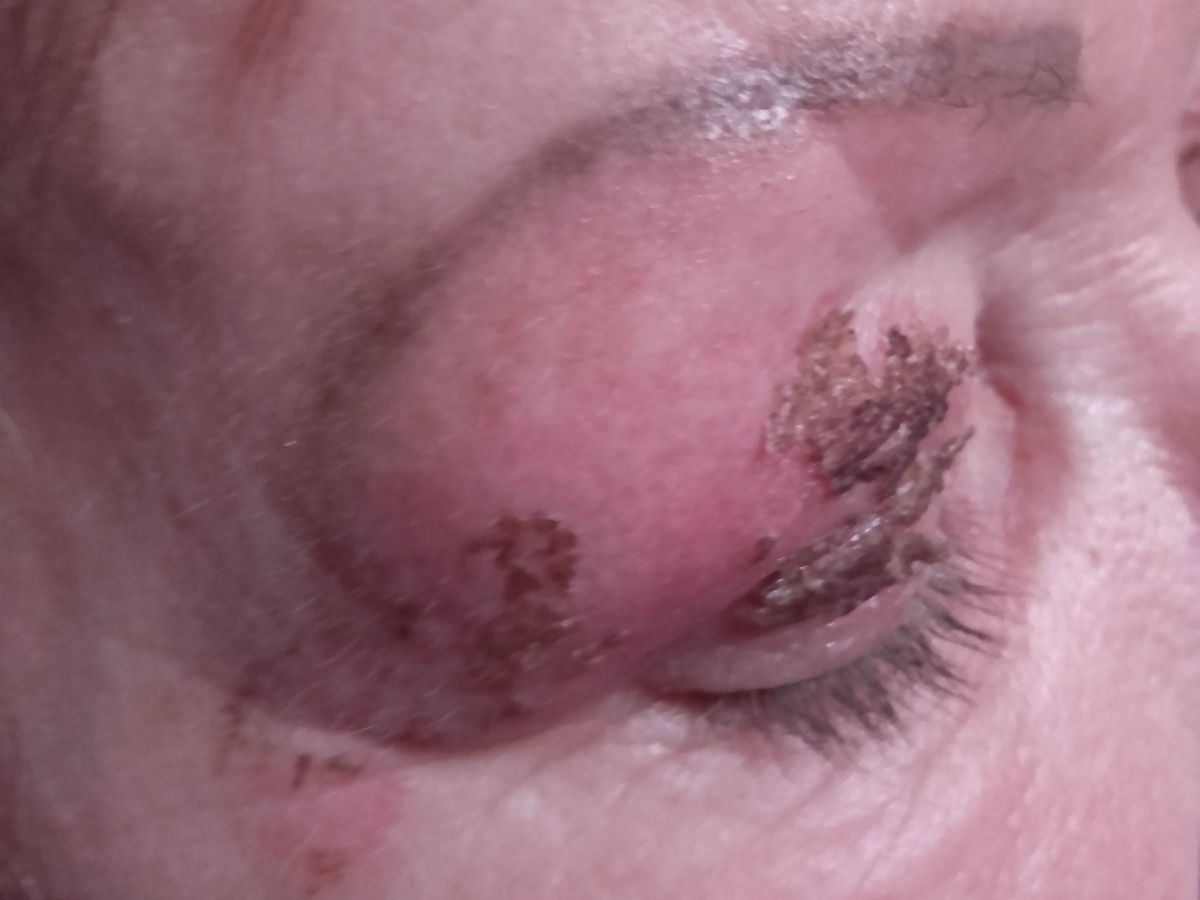
This picture shows the scabs falling off after an intense plasma upper eyelid lift procedure. Some of the scabs are still present and this picture shows clearly how as the scabs fall off, the area is noticeably red from the plasma eyelid lift procedure.
After the short-term healing, the new skin is naturally red, furthermore, the skin undergoes a further continuous slow process of regeneration and remodelling during the time it takes for the area to recover from the thermal stimulation (burn) caused by the plasma superficial skin burn. In other words, inflammation, redness and skin remodelling are an "all in one" effect of the long-term skin healing process.
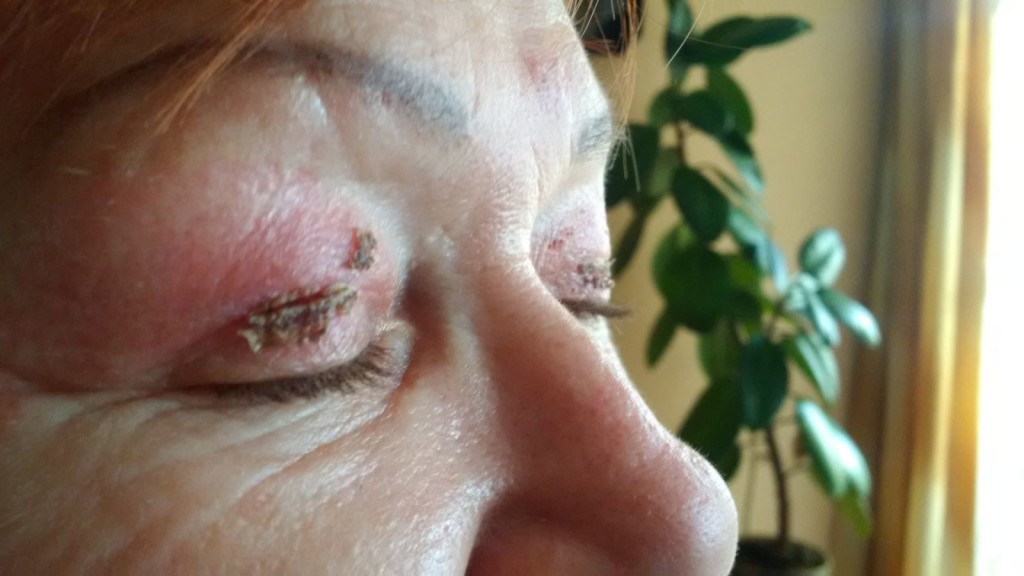
"Red Meat" colour after the scabs have just fallen off. This is a normal occurrence after plasma localised skin tightening.
Since the redness is due to the skin regeneration process, exposure to intense UV light, during the long-term healing can lead to hyper-pigmentation. As a rule of thumb, when the redness is completely over, then direct sun exposure is less likely to lead to hyperpigmentation. Furthermore, if the treatment is repeated before the long-term healing is completely over (while the area is still tender), the treatment becomes unbearably painful even using most common "over the counter" topical numbing products. Therefore as a rule of thumb, if the area is still red or tender, the treatment should not repeat until the area has returned to normal and the tenderness faded completely.
Please note that the end of the redness does not mark the end of the long-term healing. The area may still be still subject to the long-term healing even while not appearing red at all. What marks the end of the long-term healing is the end of the tenderness instead. In any case, the redness is not permanent and it subsides over time.
Tenderness and redness should not be cause for concern, because it is a normal part of the long-term recovery process. It will eventually subside on its own accord without leaving a trace as long as no exposure to intense UV light has taken place.
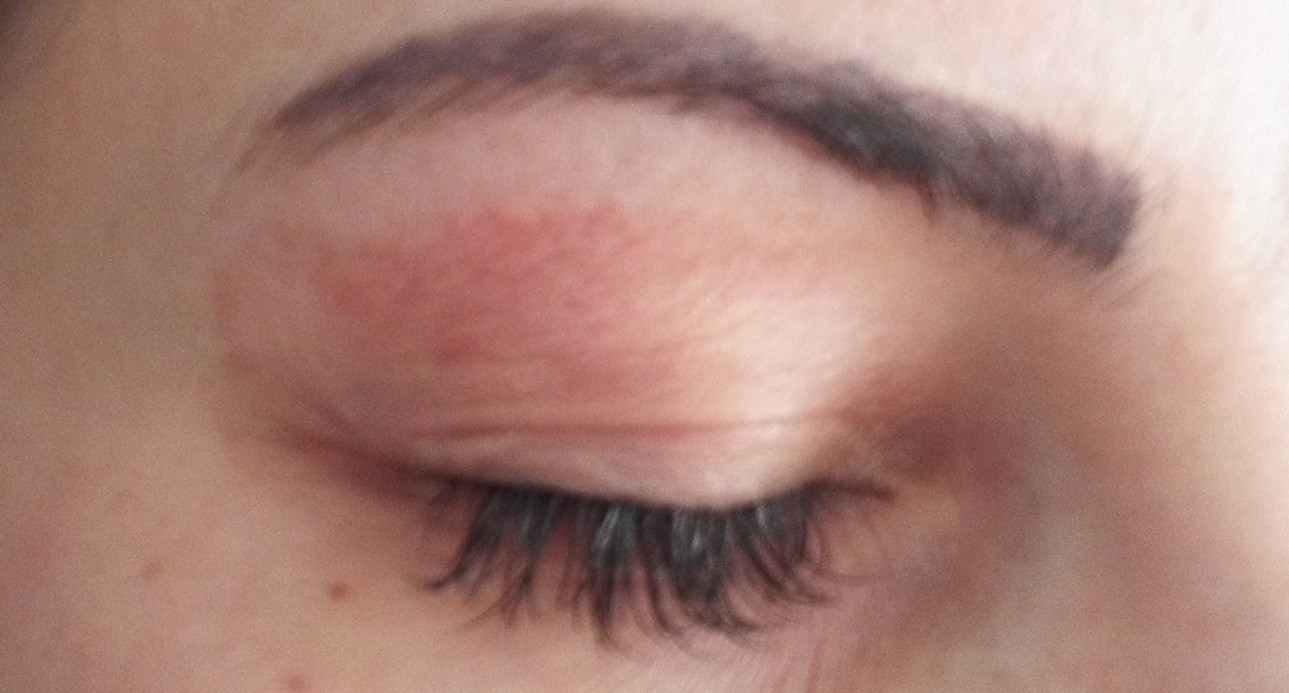
The picture was taken one month after the plasma high-intensity treatment. Redness and tenderness of the area and slight laxity after a plasma high-intensity treatment.
The following applies to high-intensity treatments without the use of any soothing or healing products:
- Itchiness. The initial feeling is of itchiness, which starts during the scabbing process and continues soon after the scabs have fallen off. It usually lasts approximately 7 to 10 days after the scabs have fallen off.
- Tenderness. While the itchy feeling subsides slowly, it is replaced by a feeling of tenderness. The degree of tenderness and its duration is dependant on the treatment intensity. The end of the long-term healing process is marked by the end of the feeling of tenderness.
- Dryness. This feeling can occur as soon as the scabs have fallen off and it can last all throughout the long-term healing period.
- A stinging feeling is also common all throughout the long-term healing when applying creams, sunscreen and cosmetics.
Even low-intensity treatments do cause similar reactions, however, the symptoms last less and their intensity is far milder. Please note that the redness can still have subsided while the healing process is still ongoing what really marks the end of the long-term healing process is the end of the tenderness.
An important aspect of the long-term healing process is the skin re-modelling.
There is usually a clear change in the skin structure immediately after the scabs have fallen off. However the change at that point is evident but not permanent, the skin structure will change over the course of the long-term healing while the skin feels still tender. The following pictures are a demonstration of the re-modelling happening over the course of a few hours after the scabs have fallen off.
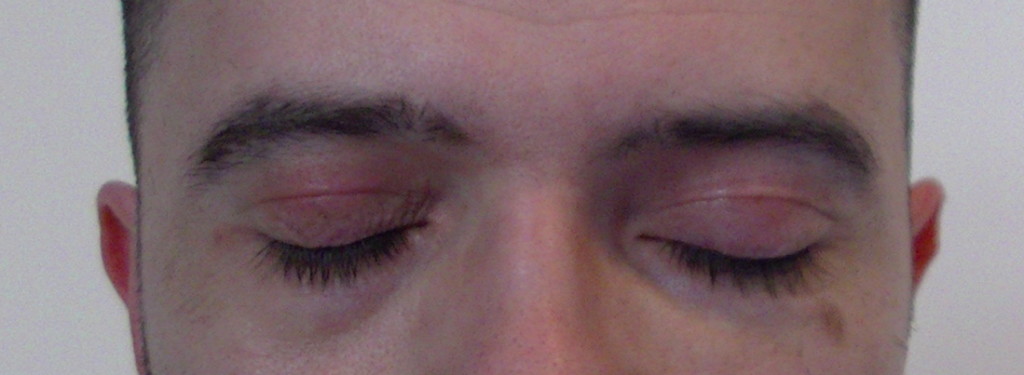
The day after the scabs have fallen off completely the area is significantly red. Some results may be apparent already in most cases, however, the area is still subject to change over the following hours and days.
After the scabs have fallen off (during the long-term healing) the change becomes significant and relatively rapid. In the picture below you can see the difference (in terms of tightening) a few hours later. However, the area is still red.
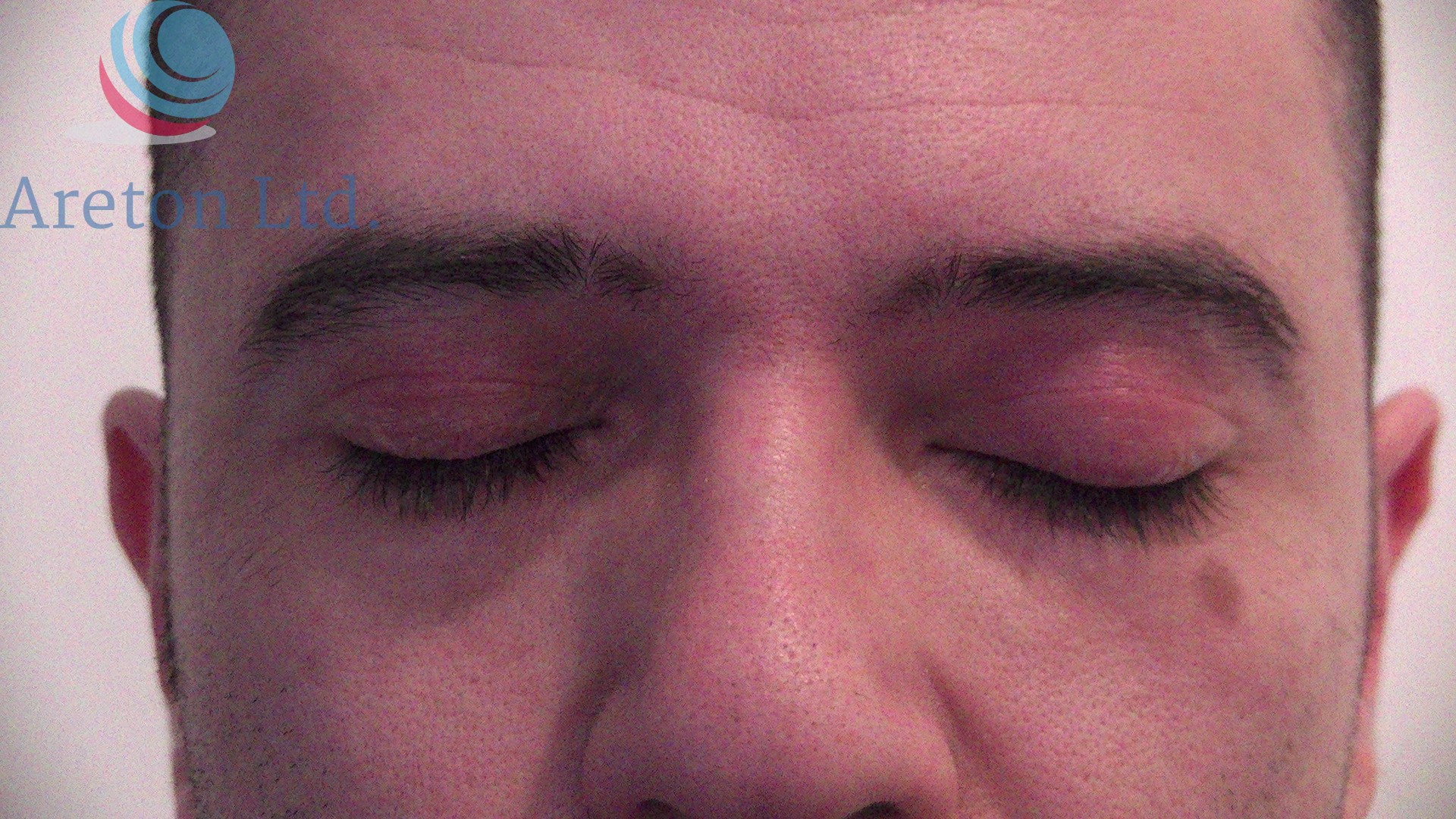
A few days after the scabs fell off after plasma eyelid lift treatment using the spray operation. The area is still red and still subject to remodelling. The area has tightened further compared to the picture taken immediately after the scabs had fallen off.
The area will be still subject to change over the course of the long-term healing. Once the tenderness is over the results can be regarded as virtually permanent.
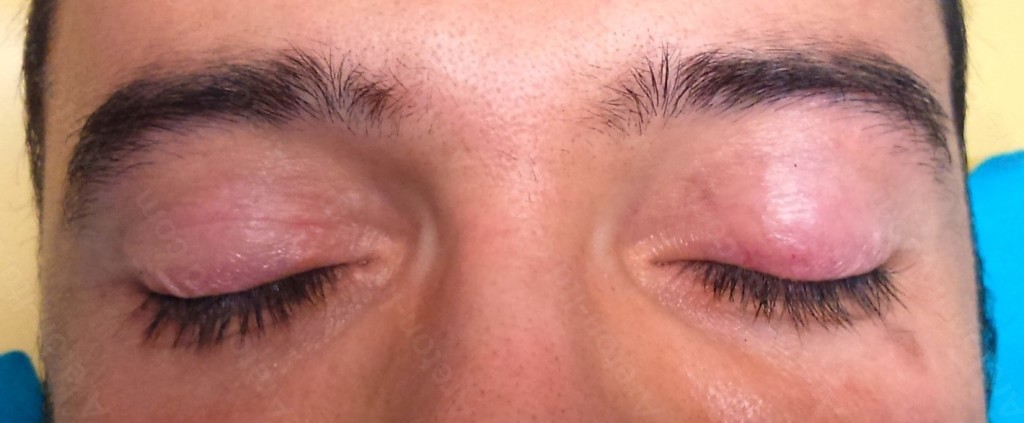
Eyelids over one year after the last plasma upper eyelid lift procedure November 2016. This is the long-term result of the plasma procedure.
Please bear in mind that the skin is a live organ and subject to change over the long-term, therefore, however, slow the skin will change over the long period even after the long-term healing process is over. Once the desired results are achieved, the treatment can be repeated when required, usually several years later.
Skin laxity is a temporary adverse reaction to the plasma eyelid tightening treatment. Please note that in all cases examined skin laxity has been a transient effect only observed during the long-term healing process while the area was still very tender. This transient effect has been observed only after high-intensity treatments.
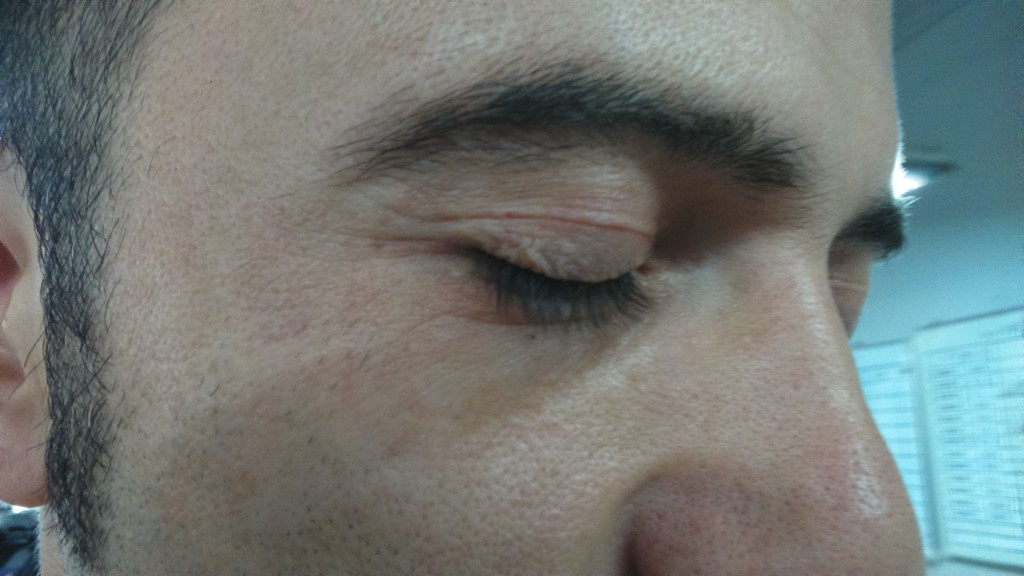
Upper eyelid laxity 3 weeks after a plasma high-intensity upper eyelid tightening treatment. This was a transient effect and it was part of the skin remodelling during the long-term healing. This effect has only been observed. after high-intensity treatments and in all cases observed this was transient. The picture was taken at the end of November 2016. The treatment was performed at the beginning of November 2016. Treatment date 7/11/2016
If skin laxity occurs, it starts to take place a few days after the scabs have fallen off on their own accord. In any case, even if the laxity is taking place the skin tightening will still occur in the long-term. Skin laxity has subsided in all cases observed.
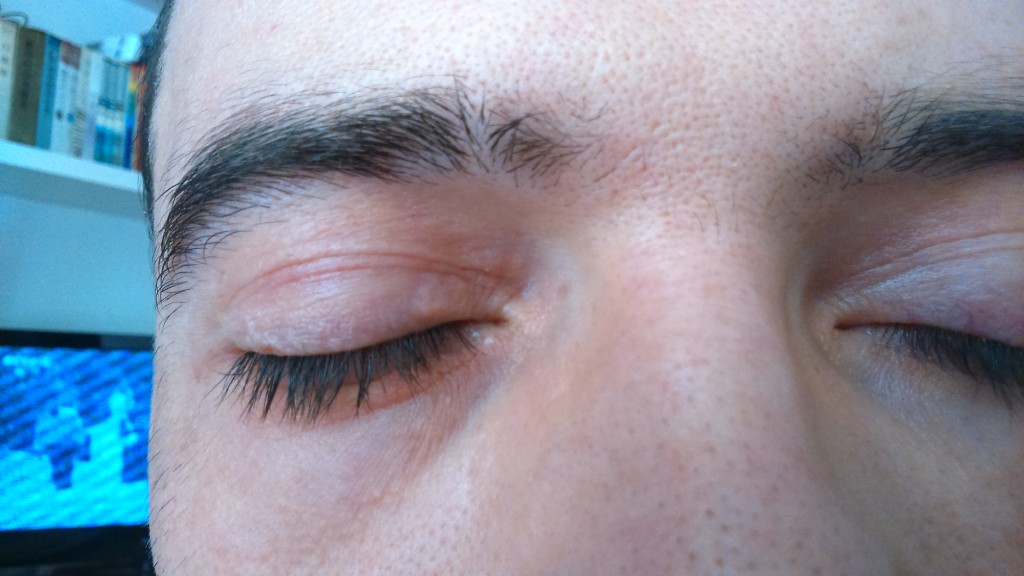
7 weeks after the treatment skin laxity has reduced dramatically, the area is still tender and redness can still be observed. 03/01/2017. Treatment date 7/11/2016
The skin laxity subsides over time as the long-term tightening takes place. Whenever observed, skin laxity has subsided within three months after the plasma upper eyelid lift treatment. Please note that the skin laxity may not take place in most cases of low/medium intensity plasma treatments.
Therefore, because high-intensity plasma treatments lead to:
- Extended periods of redness
- Extended periods of tenderness
- Skin laxity
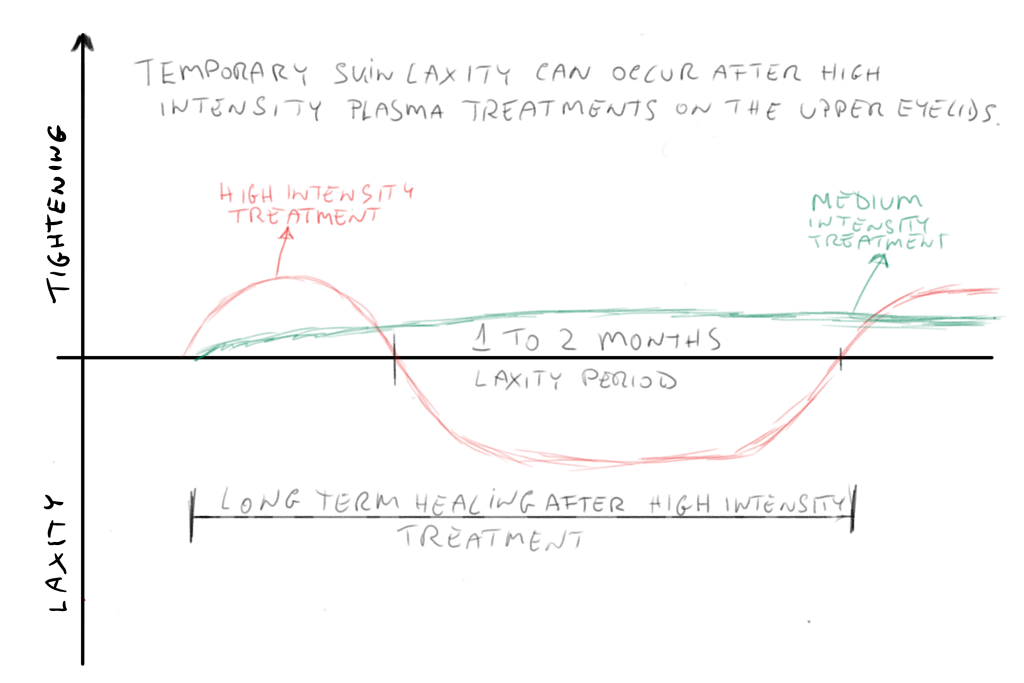
it is advisable to carry out low/medium intensity treatments instead. If the plasma eyelid rejuvenation treatment is carried out at low medium intensity, the minor improvements may be achieved without the need of going through extended periods of inflammation which can discourage people from undergoing further treatments.
Therefore even if you are an experienced practitioner in these types of procedures this is a further reason for always opting for a medium intensity treatment.
In all cases observed the redness and tenderness always subsided, hence these symptoms are all transient. To date, no case of chronic tenderness or redness has been reported despite the several thousands of high-intensity treatments performed the world over. Additionally, in case of high-intensity treatments, the temporary laxity is not a cause for concern as it is also transient.
The skin remodelling lasts as long as the area is still tender (long-term healing). Once the tenderness subsides the skin remodelling is over. This is when the results become representative.
Also, another problem reported is the presence of small atrophic red spots (sometimes lasting a number of months) where the voltaic plasma was applied. They are most likely caused by the use of makeup during the short-term healing process.
All the effects discussed here are transient, however, hyperpigmentation is the only undesired effect which may become permanent, despite that, it can be easily removed by using certain other aesthetic products.
Please note that individual results may vary. The skin reactions are also dependant on the individual.
[table caption="All information an know-how of these procedures are detailed on the online training platform VoltaicPlasma.com " width="800" colwidth="500|500|300|200" colalign="normal|normal|normal|normal"] Low-Intensity Treatment, Medium Intensity Treatment, High-Intensity Treatment, Time Lapse Some Residual Redness and Tenderness., Tenderness and Redness, Intense redness and tenderness, One week after the treatment. No Symptoms., Some residual Tenderness and Redness, Intense Redness and Tenderness, Two weeks after the treatment. No Symptoms., No Symptoms or some residual tenderness, Intense Redness and Tenderness. Skin Laxity may occur, Three weeks after the treatment. No Symptoms., No Symptoms, Redness and Tenderness. Skin Laxity may occur, Four weeks after the treatment. No Symptoms., No Symptoms, Redness and Tenderness. Skin Laxity, One month after the treatment. No Symptoms., No Symptoms, Minor Redness and Tenderness. Skin Laxity reduced, Two months after the treatment. No Symptoms., No Symptoms, No Symptoms, Three months after the treatment. [/table][:es]
Curación a largo plazo después de los tratamientos de alta intensidad de levantamiento de párpados con plasma.

Hay dos fases de curación en el estiramiento de piel localizada usando plasma eléctrico:
- Curación a corto plazo
- Curación a largo plazo
Mientras que la curación a corto plazo produce hinchazón y costras, la curación a largo plazo se ocupa de la regeneración y remodelación a largo plazo de la piel. Mientras que el primero se lleva a cabo inmediatamente después del tratamiento y finaliza en unos pocos días, el último generalmente se lleva a cabo en el transcurso de semanas, y en ocasiones incluso meses.
Durante la curación a largo plazo, la piel aún está sujeta a enrojecimiento, sensibilidad y aún se está cicatrizando. La cicatrización dura mientras rejuvenecimiento todavía está ocurriendo.
El período de recuperación de la piel a largo plazo depende de varios factores, en particular:
- La intensidad del tratamiento (recuerde que la intensidad del tratamiento depende de varios factores, y no solo de la configuración de potencia del dispositivo). En particular, cuanto más larga sea la duración del arco, más se propagará el calor dentro de la piel. Cuanto más juntas están los puntos, más intenso es el calor. En general, cuanto mayor es la intensidad del tratamiento, más intenso es el enrojecimiento después del procedimiento y cuanto más dura la curación a largo plazo.
- La duración de la curación a largo plazo también depende de la capacidad de recuperación individual de la piel.
Ciertos productos calmantes o curativos apropiados pueden reducir el tiempo requerido para el proceso de curación a largo plazo.
Si bien el proceso de curación a corto plazo se puede explicar fácilmente comparándolo con los efectos de las quemaduras de la piel y las lesiones pequeñas, el proceso de curación a largo plazo tiene que referirse a algo ligeramente diferente. Relacionamos el proceso de curación a largo plazo con el tema familiar de la regeneración de la piel después de la remoción de lunares o el proceso de recuperación de heridas menores de la piel poco después de que las costras se hayan caído. Después de que se hayan caído las costras después de los tratamientos estéticos con plasma o lesiones menores en la piel, la nueva piel suele ser roja y tiene una textura diferente al resto de la piel. El área también puede ser picante y sensible por un tiempo.
Además, el proceso de recuperación de la piel a largo plazo es similar al que ocurre después de las exfoliaciones cosméticas de la piel profunda. Al igual que en las exfoliaciones de la piel, cuanto más profunda es la penetración de la exfoliación, mayor es el enrojecimiento después del tratamiento, sin embargo, en general, el período de recuperación de la piel a largo plazo después de los tratamientos con plasma lleva más tiempo. Si bien la recuperación a largo plazo de la exfoliación puede durar hasta tres semanas (con una sensación de sensibilidad y sequedad de la piel), el enrojecimiento, la sensibilidad y la sequedad pueden durar hasta 3 meses, esto es normal y es de esperar después del plasma de alta intensidad. tratos.
Mientras que la piel todavía está roja e inflamada, todavía se está regenerando y cicatrizando. Con el fin de comprender lo que está sucediendo durante la curación a largo plazo, tomaremos el ejemplo de eliminación de lunares. Cuando la nueva piel se regenera es de un color rojo / rosa diferente y carece de pigmentación. Además, la textura es diferente.

Área unos días después de la eliminación de moles de plasma. El área es roja poco después de que la costra se haya caído. La nueva piel eventualmente regresará a su color y textura normales, por lo tanto se mezcla con la piel circundante.
Con el tiempo, la textura y el color de la piel volverán a la normalidad y será difícil saber si se realizó algún tratamiento..
Después de la eliminación de lunares, la costras se lleva a cabo. Una vez que la costra se haya caído, el área se pondrá roja y tendrá una textura de la piel notablemente diferente a la piel circundante. Esto se debe a que la nueva piel se ha formado en lugar de la vieja lesión de la piel. Cuando la nueva piel se forma, generalmente es de un color vivo y también tiene una textura de piel notablemente diferente.

Detalle o el párpado derecho unos días después de un procedimiento de extirpación de lesión cutánea benigna con plasma eléctrico. El área es roja / rosada después de que la costra se haya caído.
La diferencia de color entre el área tratada y la piel circundante se desvanecerá lentamente en las próximas semanas. Del mismo modo, la nueva textura de la piel se combinará con la piel circundante en el transcurso de las próximas semanas.
De manera similar a la remoción de lunares, después de los tratamientos de piel localizada (incluida la elevación del párpado superior con plasma), la nueva piel se pondrá roja después de que se hayan caído las costras. Lo mismo se aplica al estiramiento cutáneo localizado con plasma eléctrico. Una vez que las costras se han caído, el área es de color rojo intenso como el que se observa en la remoción de lunares. Además, en caso de un estiramiento cutáneo localizado, la piel tenderá a regenerarse debido a la estimulación térmica causada por la quemadura causada por el arco eléctrico. Por lo tanto, el enrojecimiento (inflamación) es causado por dos factores:
- la nueva piel se regenera después de la lesión menor causada por el arco eléctrico y
- La estimulación térmica causada por el tratamiento.

Esta imagen muestra las costras que se caen después de un intenso procedimiento de elevación del párpado superior con plasma. Algunas de las costras aún están presentes y esta imagen muestra claramente cómo a medida que se caen las costras, el área es notablemente roja debido al procedimiento de levantamiento del párpado con plasma.
Después de la cicatrización a corto plazo, la nueva piel está naturalmente roja, además, la piel experimenta un proceso lento y continuo de regeneración y remodelación durante el tiempo que tarda la zona en recuperarse de la estimulación térmica (quemadura) causada por el plasma superficial. quemadura de la piel. En otras palabras, la inflamación, el enrojecimiento y la cicatrización de la piel son un efecto "todo en uno" del proceso de curación de la piel a largo plazo.

"Carne roja" color después de que las costras acaban de caerse. Esto es normal después del estiramiento de piel localizada con plasma.
Dado que el enrojecimiento se debe al proceso de regeneración de la piel, la exposición a la luz UV intensa, durante la cicatrización a largo plazo puede provocar hiperpigmentación. Como regla general, cuando el enrojecimiento finaliza por completo, es menos probable que la exposición directa al sol provoque hiperpigmentación. Además, si el tratamiento se repite antes de que la curación a largo plazo termine por completo (mientras que el área aún es sensible), el tratamiento se vuelve insoportablemente doloroso, incluso utilizando los productos anestésicos tópicos "de venta libre" más comunes. . Por lo tanto, como regla general, si el área aún está roja o sensible, el tratamiento no debe repetirse hasta que el área haya vuelto a la normalidad y la sensibilidad se haya desvanecido por completo.
Tenga en cuenta que el final del enrojecimiento no marca el final de la curación a largo plazo. Es posible que el área aún esté sujeta a la curación a largo plazo, aunque no aparezca roja en absoluto. Lo que marca el final de la curación a largo plazo es el final de la sensibilidad. En cualquier caso, el enrojecimiento no es permanente y desaparece con el tiempo.
La sensibilidad y el enrojecimiento no deben ser motivo de preocupación, ya que es una parte normal del proceso de recuperación a largo plazo. Eventualmente, se calmará por sí solo sin dejar rastro, siempre que no haya habido exposición a la luz UV intensa.

La imagen fue tomada un mes después del tratamiento de plasma de alta intensidad. Enrojecimiento y sensibilidad del área y ligera laxitud después de un tratamiento de plasma de alta intensidad.
Lo siguiente se aplica a los tratamientos de alta intensidad sin el uso de productos calmantes o curativos:
- Picazón: La sensación inicial es de picazón, que se inicia durante el proceso de costras y continúa poco después de que las costras se hayan caído. Por lo general, dura aproximadamente 7 a 10 días después de que se hayan caído las costras.
- Sensibilidad Mientras que la sensación de picazón disminuye lentamente, es reemplazada por una sensación de sensibilidad. El grado de sensibilidad y su duración depende de la intensidad del tratamiento. El final del proceso de curación a largo plazo está marcado por el final del sentimiento de sensibilidad.
- Sequedad Este sentimiento puede ocurrir tan pronto como se caigan las costras y puede durar todo el período de curación a largo plazo..
- Una sensación de escozor también es común durante la curación a largo plazo cuando se aplican cremas, bloqueadores solares y cosméticos.
Incluso los tratamientos de baja intensidad causan reacciones similares, sin embargo, los síntomas duran menos y su intensidad es mucho más leve. Tenga en cuenta que el enrojecimiento aún puede haber disminuido mientras el proceso de curación aún está en curso, lo que realmente marca el final del proceso de curación a largo plazo es el final de la sensibilidad.
Un aspecto importante del proceso de curación a largo plazo es el re-cicatrización de la piel.
Por lo general, hay un cambio claro en la estructura de la piel inmediatamente después de que se hayan caído las costras. Sin embargo, el cambio en ese punto es evidente, pero no permanente, la estructura de la piel cambiará a lo largo de la curación a largo plazo mientras la piel se sienta aún sensible. Las siguientes imágenes son una demostración del re-modelado que ocurre en el transcurso de unas pocas horas después de que se hayan caído las costras.

El día después de que las costras se hayan caído completamente, el área está significativamente roja. Algunos resultados pueden ya ser evidentes en la mayoría de los casos, sin embargo, el área todavía está sujeta a cambios durante las siguientes horas y días.
Después de que las costras se hayan caído (durante la cicatrización a largo plazo), el cambio se vuelve significativo y relativamente rápido. En la siguiente imagen puede ver la diferencia (en términos de estiramiento) unas horas más tarde. Sin embargo, el área sigue siendo roja.

Unos días después de que las costras se cayeran después del tratamiento de elevación del párpado con plasma mediante la operación de barrido (Spray). El área sigue siendo roja y aún sujeta a cambio. El área se ha estrechado aún más en comparación con la imagen tomada inmediatamente después de que se cayeron las costras.
El área aún estará sujeta a cambios en el transcurso de la curación a largo plazo. Una vez que la sensibilidad ha terminado, los resultados pueden considerarse como virtualmente permanentes.

Párpados más de un año después del último procedimiento de levantamiento del párpado superior con plasma en noviembre de 2016. Este es el resultado a largo plazo del procedimiento con plasma.
Por favor, tenga en cuenta que la piel es un órgano vivo y está sujeta a cambios a largo plazo, por lo tanto, la lentitud de la piel cambiará a lo largo del período incluso después de que finalice el proceso de curación a largo plazo. Una vez que se logran los resultados deseados, el tratamiento se puede repetir cuando sea necesario, generalmente varios años después.
La laxitud de la piel es una reacción adversa temporal al tratamiento de estiramiento del párpado con plasma. Tenga en cuenta que en todos los casos examinados, la laxitud de la piel ha sido un efecto transitorio que solo se observó durante el proceso de curación a largo plazo, mientras que el área aún estaba muy sensible. Este efecto transitorio se ha observado solo después de los tratamientos de alta intensidad.

Laxitud del párpado superior 3 semanas después de un tratamiento de estiramiento del párpado superior de plasma de alta intensidad. Este fue un efecto transitorio y fue parte del rejuvenecimiento de la piel durante la curación a largo plazo. Este efecto solo ha sido observado. Después de los tratamientos de alta intensidad y en todos los casos observados esto fue transitorio. La fotografía se tomó a finales de noviembre de 2016. El tratamiento se realizó a principios de noviembre de 2016. Fecha de tratamiento 7/11/2016
Si la laxitud de la piel ocurre, comienza a ocurrir unos días después de que las costras se hayan caído por su propia cuenta. En cualquier caso, incluso si la laxitud se está produciendo, el estiramiento de la piel seguirá ocurriendo a largo plazo. La laxitud de la piel ha disminuido en todos los casos observados.

7 semanas después del tratamiento, la laxitud de la piel se ha reducido drásticamente, el área aún está sensible y se puede observar enrojecimiento. 01/03/2017. Fecha de tratamiento 7/11/2016
La laxitud de la piel disminuye con el tiempo a medida que se produce el ajuste a largo plazo. Cada vez que se observa, la laxitud de la piel ha disminuido dentro de los tres meses posteriores al tratamiento de elevación del párpado superior con plasma. Tenga en cuenta que es posible que la laxitud de la piel no se produzca en la mayoría de los casos de tratamientos con plasma de intensidad baja / media.
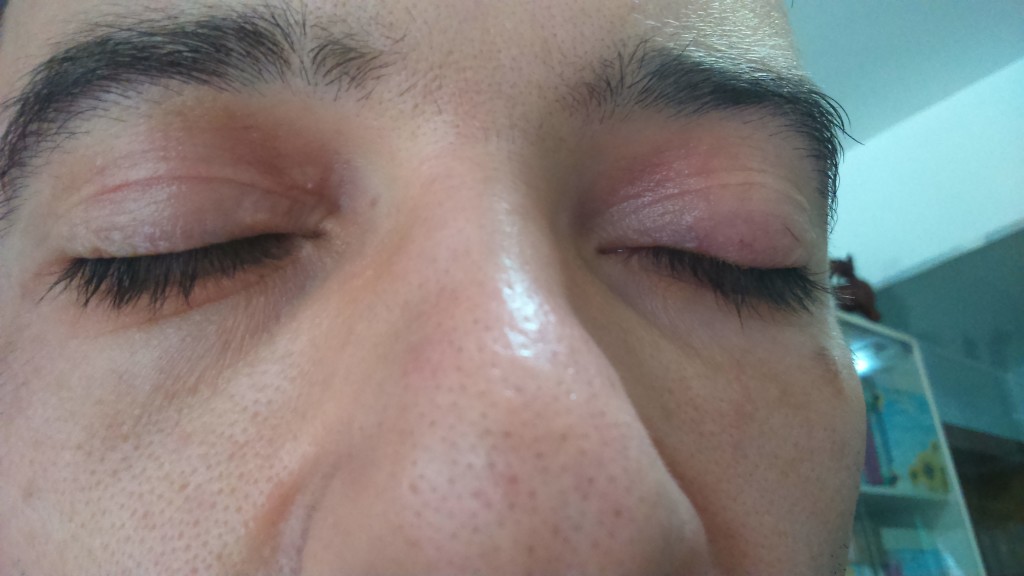
14/01/2017 laxitud reduciendo con el tiempo. estiramiento teniendo lugar durante la curación a largo plazo..
Por lo tanto, los tratamientos con plasma de alta intensidad conducen a:
- Períodos prolongados de enrojecimiento
- Períodos prolongados de sensibilidad
- Laxitud de la piel

Es recomendable realizar tratamientos de intensidad baja / media. Si el tratamiento de rejuvenecimiento de los párpados con plasma se realiza con una intensidad media baja, se pueden lograr mejoras menores sin necesidad de pasar por períodos prolongados de inflamación, lo que puede desalentar a las personas a someterse a tratamientos adicionales.
Por lo tanto, incluso si usted es un profesional experimentado en este tipo de procedimientos, esta es otra razón para optar siempre por un tratamiento de intensidad media.
En todos los casos observados, el enrojecimiento y la sensibilidad siempre disminuyeron, por lo que estos síntomas son transitorios. Hasta la fecha, no se han reportado casos de dolor crónico o enrojecimiento a pesar de los miles de tratamientos de alta intensidad realizados en todo el mundo. Además, en el caso de tratamientos de alta intensidad, la laxitud temporal no es motivo de preocupación, ya que también es transitoria.
El rejuvenecimiento de la piel dura todo el tiempo que el área aún esté sensible (curación a largo plazo). Una vez que la sensibilidad cede, el rejuvenecimiento de la piel ha terminado. Esto es cuando los resultados se vuelven representativos.
Además, otro problema reportado es la presencia de pequeñas manchas rojas atróficas (que a veces duran varios meses) donde se aplicó el plasma voltaico. Lo más probable es que sean causados por el uso de maquillaje durante el proceso de curación a corto plazo.
Todos los efectos mencionados aquí son transitorios, sin embargo, la hiperpigmentación es el único efecto no deseado que puede volverse permanente, a pesar de eso, puede eliminarse fácilmente mediante el uso de otros productos estéticos.
Tenga en cuenta que los resultados individuales pueden variar. Las reacciones cutáneas también dependen del individuo.
[table caption="All information an know-how of these procedures are detailed on the online training platform VoltaicPlasma.com " width="800" colwidth="500|500|300|200" colalign="normal|normal|normal|normal"] Tratamiento de baja intensidad., Tratamiento de intensidad media., Tratamiento de alta intensidad., Lapso de tiempo., Algunos enrojecimiento y sensibilidad residual., Sensibilidad y enrojecimiento., Enrojecimiento y sensibilidad intensos., Una semana después del tratamiento. No hay síntomas., Alguna sensibilidad residual y enrojecimiento., Enrojecimiento intenso y sensibilidad., Dos semanas después del tratamiento. No hay síntomas., Sin síntomas o algo de sensibilidad residual., Enrojecimiento intenso y sensibilidad. Laxitud de la piel puede ocurrir., Tres semanas después del tratamiento. No hay síntomas., Sin síntomas., Enrojecimiento y sensibilidad. La laxitud de la piel puede ocurrir., Cuatro semanas después del tratamiento. No hay síntomas., Sin síntomas., Enrojecimiento y sensibilidad. Laxitud de la piel., Un mes después del tratamiento. No hay síntomas., Sin síntomas., Enrojecimiento y sensibilidad menores. Reducción de la laxitud de la piel., Dos meses después del tratamiento. No hay síntomas., Sin síntomas., Sin síntomas., Tres meses después del tratamiento. [/table][:]
